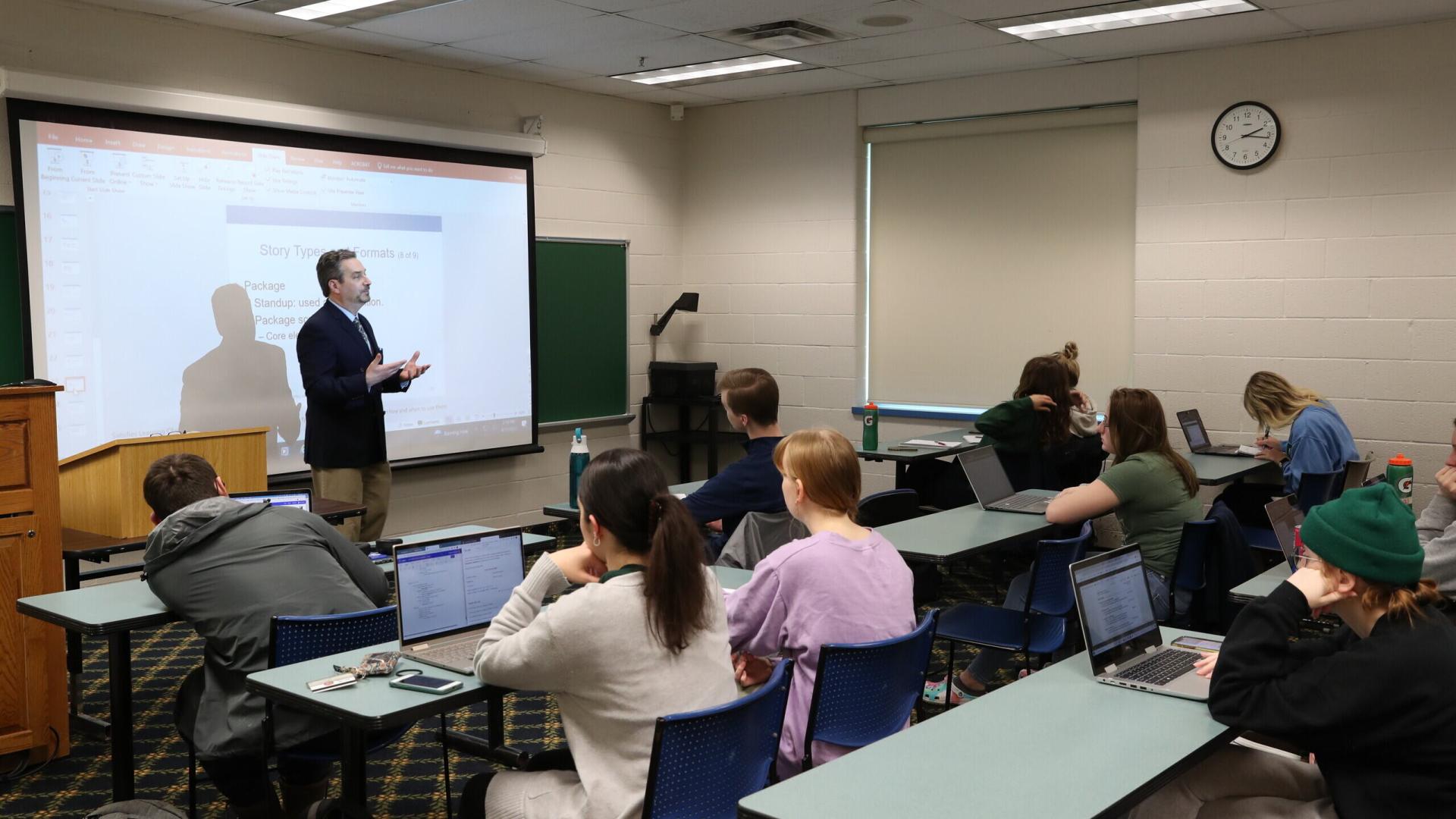
Communication
Your professors in the Communication program will work with you to create the academic path that results in the career of your dreams. There is no one-size-fits-all approach to learning. When you study Communication, your professional and personal goals matter, and you’ll take an active role in building a plan that provides the skills and experience needed for success in the modern business world.
No matter which classes you chose, this program is centered around the powerful skill of storytelling. Journalists use it to deliver compelling news; corporate communication specialists use it to shape an organization’s image; and social media strategists use it to engage followers and build brands. You’ll learn the skills to be a strong storyteller and content creator through non-fiction writing, multimedia, video production, public speaking, and data collection and expression.
Your experiences in the program will also prepare you to strategically tailor your message to a variety of audiences through different media platforms, both digital and traditional. The versatility of this degree allows students to pursue a number of careers in traditional media, writing, multimedia, social media, and strategic or corporate communication. Some of our students also choose to advance their study of communication through graduate school, where they often specialize in mass communication, journalism, communication and technology, and corporate communication.
- ACCT 101: Principles of Accounting (3 credits)
- MGMT 120: Principles of Management (3 credits)
- MKTG 162: Principles of Marketing (3 credits)
- DANC 200: Intro. to Arts Administration (3 credits)
- DANC 475: Arts Management Internship (3 credits)
- ART 128: Graphic Design Basics (3 credits)
- COM 240: Digital Video Production (3 credits)
- COM 260: Intro. to Social Media (3 credits)
- ART 321: Intro. to Website Design (3 credits)
- COM 312: Communication & Social Responsibility (3 credits)
- COM 314: Global Communications (3 credits)
- COM 330: Web & Social Media Analytics & Strategies (3 credits) Requires COM 260 to be taken previously or concurrently.
- ART 100 Drawing I (3 credits)
- ART 122 or 123 Art History (3 credits)
- ART 125 2-Dimensional Design (3 credits)
- ART 126 3-Dimensional Design (3 credits)
- Basic Level 2-D Studio (3 credits)
- Basic Level 3-D Studio (3 credits)
- Art Electives (2) (3 credits)
- ART 122 Ancient to Medieval Art History (3 credits)
- ART 123 Renaissance to 20th Century Art History (3 credits)
- ART 128 Basic Computer Design (3 credits)
- ART 223 History of Modern Art (3 credits)
- ART 224 History of Photography (3 credits)
- ART 230 Graphic Design History (3 credits)
- ID 220 History of Interior Design (3 credits)
- ID 221 History of Architecture (3 credits)
- ARTH 125 Art Therapy I (3 credits)
- ARTH 225 Art Therapy II (3 credits)
- ARTH 325 Art Therapy III (3 credits)
- PSYC 101 Intro to Psychology (3 credits)
- ART 100 Drawing I
- ART 102 Ceramics I
- ART 128 Basic Computer Design
- COM 101: Communication in Society (3 credits)
- COM 102: Interpersonal Communication (3 credits)
- COM 260: Introduction to Social Media (3 credits)
- Students must take three additional courses within the Communication Department, two of which must be 300-level or higher.
- ARTH 125: Intro to Expressive Therapies (3 credits)
- PSYC 101: Intro to Psychology (3 credits)
- One developmental psychology course (3 credits):
- PSYC 241: Developmental Psychology: Childhood,
- PSYC 242: Developmental Psychology: Adolescence, or
- PSYC 142: Lifespan Development
- Abnormal Psychology (3 credits)
- COM 210: Mindful Communication (3 credits), ARTH 275 (3 credits): Group Practices, or SOC 204: Diversity in Society (3 credits)
- And a least two courses in creative fields or modalities with prefixes ART, ARTH, THEA, DANC, MUS (6 credits) (At least one should be a 200-level or higher)
- ART 100 Drawing I (3 credits)
- ART 125 2-Dimensional Design (3 credits)
- ART 128 Basic Computer Design (3 credits)
- ART 220 Introduction to Graphic Design (3 credits)
- ART 221 Digital Imagery (3 credits)
- 3 Approved Graphic Design Electives (3 credits)
- ART 106 Photography I
- ART 128 Basic Computer Design
- ART 206 Intermediate Photography
- ART 223 History of Modern Art
- ART 224 History of Photography
- ART 305 Digital Photography
- ART 306 Color Photography
- ART 400 Individualized Studio I
- ART 128: Graphic Design Basics (3 credits)
- ART 221: Digital Imagery (3 credits)
- ART 321: Introduction to Website Design (3 credits)
- COM 260: Intro to Social Media (3 credits)
- ART 225: Computer Illustration Technology (3 credits)
- ART 325: Intermediate Website Design (3 credits)
- ART 326: Advanced Website Design (3 credits)
OR - COM 202: Contemporary Media Literacy (3 credits)
- COM 240: Digital Video Production I (3 credits)
- COM 330: Digital analysis & Strategies (3 credits)
- THEA 110: Acting I (3 credits)
- THEA 245: Script Analysis: From Page to Stage (3 credits)
- THEA 290: Topics in Theatre History (3 credits)
- THEA 401: Practicum (3 credits)
Consists of 21 credits as follows:
2 electives of the following, at least one 300-level course.
A Communication minor complements various majors and allows students to refine their professional and creative skills further. The minor includes six courses, consisting of 18 credits.
Required Courses
Course Choices (9 credits)
Minors (unless permitted by the Department Chair) are not able to take COM 390: Professional Development or COM 473/475: Internship.
The Social Media and Web minor integrates with a student’s chosen major to harness the power of convergence and analytics by training students to use emerging technologies and web-based communication. Combined with their major field of study, the Social Media and Web minor prepares students to be skilled practitioners in the new media landscape. The courses enable students to participate in and adapt to cyberspace’s virtual forum through proper protocols informed by communication theory. Students who are majors may pursue the Minor Electives Cluster in Website Design in the Art Department. In contrast, Graphic Design majors may pursue the Minor Electives Cluster in Communication.
Required Courses
Minor Electives Clusters (Choose one: if courses in the minor cluster are required for your major, please take the opposite cluster.)
This student-led organization creates media for a variety of platforms, including YouTube and Spotify. Members utilize Laker TV studios, a video production lab that telecasts on Spectrum Cable in the City of Erie, and a Digital Audio Lab for creating podcasts and streaming audio. The club features multiple branches, including audio/radio, blogging, gaming, TV production, new digital communication platforms, sports broadcasting, broadcast journalism, and videography/photography. It provides not only fun in working with other like-minded creative students but helps the student build his/her media portfolio. All majors are welcome to join.
Fast Facts
- Hands-on experience begins as soon as freshman year with access to Laker Student Media. This multi-platform student-led organization creates content for YouTube, TikTok, Instagram, and Spotify
- A professional development course sets our graduates up for success; Students learn to perform deep-dive job searches, practice interviewing, create online resumes and digital portfolios, and develop professional skills
- Our alumni have become social media managers, television, radio and print journalists, public relations executives, event planners, business owners, teachers, lawyers, and advertising and sales executives
- Many companies waive the experience requirements to hire our students right after graduation due to the practical experience of working with real-world clients through in-class projects and internships
Course Requirements
- COM 101: Communication in Society (3 credits)
- COM 110: Oral Communication (3 credits)
- ART 128: Basic Computer Design (3 credits)
- COM 210: Mindful Communication (3 credits)
- COM 211: Comm. Theory & Research/Sophomore Review (3 credits)
- COM 240: Digital Video Production I or approved video production class (3 credits)
- COM 260: Intro. to Social Media (3 credits)
- COM 310: Human Behavior & Persuasion (3 credits)
- COM 352: Multimedia Writing (3 credits)
- COM 431: Strategic Communication (3 credits)
- At least six courses (18 credits) at the 300 level & two courses (6 credits) at the 400 level in major cluster electives
Learning Outcomes
- Identify critical information relating to the history, laws, and ethics of communication and the individuals responsible for shaping it
- Explain and apply general theories and research methods used in communication
- Demonstrate proficiency in oral communication in both small and large group settings
- Write clearly and correctly in the style appropriate for the audience and objective
- Develop an understanding of and practice skills in current and emerging communication technologies relevant to the student’s area of interest
- Demonstrate accumulated knowledge within professional settings and situations
Brian Sheridan, M.A.
Program Director, Communication Program
Office: Hirt 108
Meet the Faculty
Art, Design, and Communication








